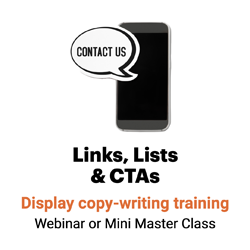Coin a word, go graphic and more
Stuck for a catchy title that will make people read the article?

Next time you’re writing catchy headlines for blog posts, email marketing, social media, online business communications or other pieces of content, try these types of headlines:
Alliteration
Here’s a catchy headline template: Use alliteration.
Alliteration occurs when you repeat initial sounds in nearby words: “Sweet smell of success,” for instance. It “makes your language lyrical,” says Sam Horn, author of POP! Stand Out in Any Crowd.
That’s the approach Eastman Chemical communicators used when they wrote this headline, summarizing some of the things the company’s R&D department had worked on recently:
Satellites, Soap and Succotash
And The New York Times used alliteration for this headline package:
Tutus and testosterone
Men behaving balletically
This approach can make a good headline.
Learn more about alliteration.
Graphic wordplay
When the Minneapolis Star Tribune ran a photo of a sign from which the “R’s” were missing, copy editors wrote this headline:
Thief st ikes again
One approach for a catchy headline: Use type to twist a phrase.
Graphic wordplay can be as simple as a headline that says:
Make Fewer Mitsakes
The Minneapolis copy editors used graphic wordplay for this headline and deck:
He (subject) teaches (verb) grammar (object)
Mike Greiner is old-school about teaching students how sentences are built, despite what one student wrote: ‘You’re torturing us’
Copyeditors at the Omaha World-Herald earned an ACES award for a portfolio including this headline:
Space rock to get thisclose to Earth
Scientists say an asteroid hurtling our way will miss us by a mere 200,000 miles.
Scott Beckett, a copy editor at Scripps central desk in Corpus Christi, Texas, submitted this ACES award winner:
Education = More chances2
Grant gives San Pat students opportunities in math, science
(Note: Search engines don’t love these headlines. So use them for email, not listing posts.)
Half-and-half words
When Dixie Land (yes!) needed a headline for a piece about punishing workouts, the copyeditor for The Arkansas Democrat-Gazette wrote:
Exercism
Intimidating or spine-chilling physical psyche-outs possess a fitness center client
Can’t find the perfect term for your headline? Make it up! For this technique, you create a new word by gluing two old words together.
Indeed, several ACES winners coined words for their winning headlines:
Penitence goes mobile with new confession app
Software makes it easy to say, ‘Forgive me father, iSinned’
— copyeditors at The Detroit News
Short and Tweet
Twitterature: the new art of adding stories to your posts
— Marianne Tamburro, copyeditor for The Star-Ledger
Bon app-étit
As iPads become a kitchen staple, digital cookbooks enhance the experience of following a recipe
— copyeditors at The Oregonian
Dinosaurigami
More pop-ups from the ‘Prehistorica’ team of Sabuda and Reinhart
— Gregory Cowles of The New York Times
One-word headlines
Here’s a headline formula that’s easy to implement: “See if there is ONE word that captures the essence of your subject,” suggests Horn. “A one word title is more likely to JUMP! off the page.”
Her own book title is a good example of this approach:
POP!
Stand Out in Any Crowd
Make your title jump off the page in a single word.
Onomatopoeia
Buzz, crash, whirrr, splash. Onomatopoeia — Greek for name-making — is a word that imitates the sound it represents.
Headline writers at The Lexington (Ky.) Herald-Leader used that approach for this ACES winner:
Squeeeak … Slam! Sniffff … Ahhhh!
Screen doors let in fresh air and nostalgia
Poignancy
Too often we think of feature headlines as clever heads for cute stories. The New York Times copy editors remind us that feature heads work well for emotional — even agonizing — pieces, as well.
Several ACES winners have used this approach for their award-winning heads. Copy editors for the Los Angeles Times, for instance, came up with this headline and deck:
Surrounded by her son
The mother of NFL player Chris Henry wanted to meet the people who received his organs. From one death, four lives were reborn
Don’t think of feature headlines as purely clever heads for cute stories. Expand your repertoire by writing poignant heads for touching stories, too.
Questions
“Declarations sit on the page,” Horn says. “Questions engage.”
Indeed, well-crafted question headlines can draw your reader in. To write a good question head:
Peggy Boss Barney, copy editor for the Salt Lake Tribune, posed a provocative question in this ACES award-winning headline:
What Do You Get When You Cross a Human With a Mouse?
A narrowing of laws on manipulating life, patent applicants hope
Question leads can help you avoid giving away the ending. Roy Peter Clark, editorial guru at the Poynter Institute, suggests that instead of:
Heroic measures save heroic dog
Brutis kept a deadly snake from his master and her grandchildren, but needed some quick help in turn to keep from dying from the bite
You consider:
Would heroic measures save heroic dog?
Brutis kept a deadly snake from his master and her grandchildren. Would the antivenin arrive in time to save the dog from dying from the bite?
Try it. As Paula LaRocque, author of Championship Writing, writes: “A headline with a question mark is inherently more open and engaging than a statement headline.”
Single-syllable words
Short words are powerful words.
They clip along at a brisk rate, can look great graphically and say a lot in a little space. Plus — sometimes most important if you’re writing to a strict space limitation — they fit.
To pack a punch in your next headline, try limiting yourself to only one-syllable words. Here are some examples to get you started.
For an article about taking private jets instead of commercial airlines in Northern Trust’s Northern Update marketing magazine, Loring Leifer wrote this pithy head:
Jet Set Go
Mary Forgione, copy editor for the Los Angeles Times, earned an ACES award for this string of super-short words:
Life After Plop, Plop, Fizz, Fizz
In her book, an advertising lion reflects on making it in a man’s world
Jennifer Balderama, copy editor for the Washington Post, used only one-syllable words for this ACES award-winner:
Ears wide shut
Researchers get punished for telemarketers’ crimes
David Breen, copy editor for the Orlando Sentinel, slipped a two-syllable word into this headline, another ACES winner. But the clip of short words following it are certainly worth emulating:
Divorce: Log on, click in, break up
But critics say an online divorce is not hassle-free; others fear it’s too easy
Still, the real queen of the one-syllable-word head is Debbie Sprong, copy editor for the Elkhart Truth. She earned an ACES award for these heads:
Cap and gone
(For an infographic on graduation)
Poll vault
New numbers in Second District race show strong lead for Chocola
Time out
For many workers, lunch hour is more than a chance to eat
Waste not
Officials hope test plot proves merits of biosolid compost
Gregory Cowles of The New York Times earned an ACES award for a portfolio of heads including these:
Swing Set
A collection of picture books teaches children about jazz and its heroes
The Way of No Flesh
A cultural history of vegetarianism in the West
And Scott Beckett, copy editor for the Corpus Christi Caller-Times, called out his short words in this ACES award-winning headline:
Nature’s 4-letter words: Wind, hail, rain
Violent storm destroys home, topples big rigs
For a preview of fall TV shows, Pat Myers of The Washington Post wrote:
Ewws and Ahhs
Too Many Shows Will Give Viewers the Creeps This Season, but a Few Noble Souls Save the Day
Steve Byers of the Huntsville (Ala.) Times limited himself to one-syllable words for this headline:
The spies who love me
Scared parents of teens spending on surveillance
Jeff Verbus of The Repository (Canton, Ohio) had two winning heads using only super-short words:
Knock down, drag out blight
Mounting expenses won’t deter Canton from ridding city of eyesore properties
Bill to squeeze pop has juice
Senator proposes a limit or ban on sale of soda in public schools
Try writing headlines using only one-syllable words. The result may well pack more of a punch than headlines using longer words.

Leave a Reply